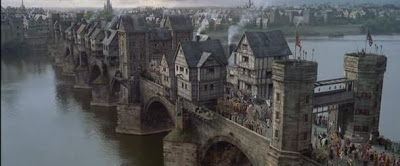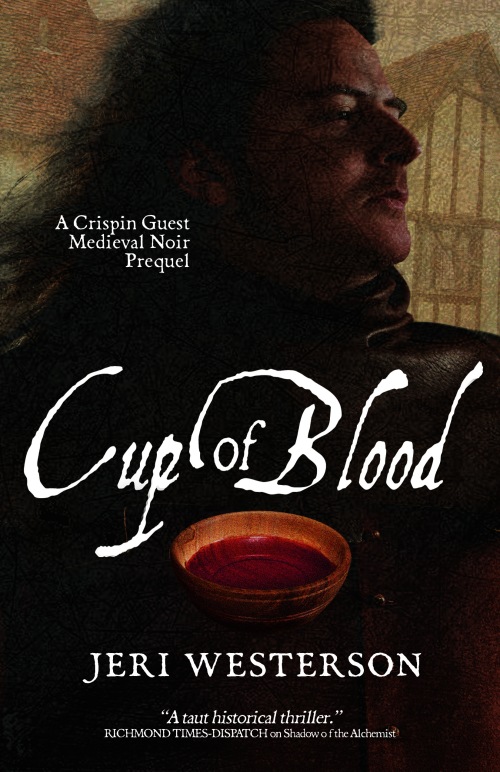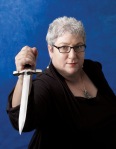Confession time...I'm really excited about reading CUP OF BLOOD. Medieval noir, doesn't get much better! Looks like an excellent place to spend some time & since it's a prequel, I'm not out of sequence or missing a thing. Who else finds this tantalizing?
Fog, a constant drizzle, gray. The miserable cold and dank of London conjures in our minds shadowy figures of Jack the Ripper, or the scurrilous deeds of Mr. Hyde. But go back further before street lamps, before the Victorians cast their gloomy sway over the city. A hundred, two hundred, six hundred years before London and Westminster melded together, and you have descended into the shadowy realm of fourteenth century London, where my medieval detective, Crispin Guest, dwells.

Of course, the streets and narrow lanes of the medieval mayhem I love so well are long gone. London was devastated by fires and simply by the whims of Newer, Better, Bigger as time marched on. The medieval London of my darkest imaginings no longer exists.
Recreating a time gone by is one of my favorite things to do. You need not spend pages and pages on description if you get a few key things mentioned. And it takes research, something I am quite fond of. For instance, those pea soup fogs London is so famous for didn’t happen until the industrial age of coal fires in homes and factories. In fact, they don’t happen anymore because the Clean Air Act of 1956 banned the use of coal for domestic fires in urban areas like London. But in the late thirteen hundreds where my novels take place, London was three square miles of town, surrounded by marsh and pastureland. Fifty thousand people inhabited it, crammed together in the first “high-rises.” Because they couldn’t build outward, they built upward into two and three-story structures. Sanitation became an issue without the advent of sewers, and laws were drawn and enforced to prevent lazy citizens from simply dumping chamber pots out of the windows onto the streets. Still, such close quarters was cause for disease to spread, and with limited medical knowledge, physicians could do little, though they understood well enough to quarantine the truly sick.
![the-shambles-6[2]](http://seawitchreviewsfromthebookshelf.files.wordpress.com/2014/08/the-shambles-62.jpg)
I’d rather time travel to a place far from my own experience, far from the nightly news. Somewhen else is far more appealing, and the medieval period comes with its own idealized settings, though I like to mix the romance of it with the stark reality. It wasn’t all laying down one’s cloak so a lady doesn’t soil her slippers. Chivalry was a set of virtues that a knight was to live by, but it was more about warfare than the ladies, though it is intimately entwined with the burgeoning notion of “courtly love,” that sighing about one’s lady love from afar, from taking her token into battle or the joust. This, too, can be twisted into an intricate tale of murder and mystery. Since my protagonist was himself a knight who lost his title, his wealth, and his lands to reinvent himself on the mean streets of London as the “Tracker,” a man who is hired to find things, including murderers, he sometimes finds himself pitting his intense sense of honor against his better judgment. In my fifth book, BLOOD LANCE, he must step in to secretly fight a joust in the place of another to satisfy honor, but might, in the offing, get himself killed. “And for what?” he begins to wonder.

In my newest book,
CUP OF BLOOD, it is a prequel to the series, and Crispin must fight the demons of his past as well as search for the now seemingly very real Holy Grail before it can be snatched for a greedy purpose by minions of the false pope in France. With my plots always having to do in some way or another with a religious relic or venerated object, I try to find scenarios that wouldn’t translate to the modern, though Crispin Guest is a hardboiled detective in the style of Raymond Chandler’s Philip Marlowe or Dashiell Hammett’s Sam Spade.
I find that readers like to visit the past and follow a mystery at the same time. The genre offers those layers, because while they get to know Crispin, my knight turned detective, and follow along as he discovers clues, they get to vicariously live his swashbuckling adventures, observe his poignant tête-à-tête with his young apprentice Jack Tucker as the lad grows up in each subsequent book, and at the same time, they learn a bit of medieval history and perhaps some tidbits they had never heard of before.
It’s a good thing I can visit medieval London in my imagination. I can well see the crooked, narrow lanes, the towering two and three-story shops and houses precariously leaning into the street. Running gutters wending their way down muddy avenues. Smoke from countless hearths curling along slate and tile roofs. Geese and sheep being herded down from the countryside to the markets. Horses pulling carts. Merchants calling their wares with their carved wordless signs hanging above their heads. The sights, the smells, the sounds.
And then, deep in the shadows, a dagger flashes and a body falls to the mud. That’s my kind of place.
---

Jeri spends time in the past in her medieval mysteries, but she had time on her website to create Crispin’s blog, book discussion guides, and excerpt of CUP OF BLOOD, and a series book trailer. See it all at www.JeriWesterson.com.
 Of course, the streets and narrow lanes of the medieval mayhem I love so well are long gone. London was devastated by fires and simply by the whims of Newer, Better, Bigger as time marched on. The medieval London of my darkest imaginings no longer exists.
Recreating a time gone by is one of my favorite things to do. You need not spend pages and pages on description if you get a few key things mentioned. And it takes research, something I am quite fond of. For instance, those pea soup fogs London is so famous for didn’t happen until the industrial age of coal fires in homes and factories. In fact, they don’t happen anymore because the Clean Air Act of 1956 banned the use of coal for domestic fires in urban areas like London. But in the late thirteen hundreds where my novels take place, London was three square miles of town, surrounded by marsh and pastureland. Fifty thousand people inhabited it, crammed together in the first “high-rises.” Because they couldn’t build outward, they built upward into two and three-story structures. Sanitation became an issue without the advent of sewers, and laws were drawn and enforced to prevent lazy citizens from simply dumping chamber pots out of the windows onto the streets. Still, such close quarters was cause for disease to spread, and with limited medical knowledge, physicians could do little, though they understood well enough to quarantine the truly sick.
Of course, the streets and narrow lanes of the medieval mayhem I love so well are long gone. London was devastated by fires and simply by the whims of Newer, Better, Bigger as time marched on. The medieval London of my darkest imaginings no longer exists.
Recreating a time gone by is one of my favorite things to do. You need not spend pages and pages on description if you get a few key things mentioned. And it takes research, something I am quite fond of. For instance, those pea soup fogs London is so famous for didn’t happen until the industrial age of coal fires in homes and factories. In fact, they don’t happen anymore because the Clean Air Act of 1956 banned the use of coal for domestic fires in urban areas like London. But in the late thirteen hundreds where my novels take place, London was three square miles of town, surrounded by marsh and pastureland. Fifty thousand people inhabited it, crammed together in the first “high-rises.” Because they couldn’t build outward, they built upward into two and three-story structures. Sanitation became an issue without the advent of sewers, and laws were drawn and enforced to prevent lazy citizens from simply dumping chamber pots out of the windows onto the streets. Still, such close quarters was cause for disease to spread, and with limited medical knowledge, physicians could do little, though they understood well enough to quarantine the truly sick.
![the-shambles-6[2]](http://seawitchreviewsfromthebookshelf.files.wordpress.com/2014/08/the-shambles-62.jpg) I’d rather time travel to a place far from my own experience, far from the nightly news. Somewhen else is far more appealing, and the medieval period comes with its own idealized settings, though I like to mix the romance of it with the stark reality. It wasn’t all laying down one’s cloak so a lady doesn’t soil her slippers. Chivalry was a set of virtues that a knight was to live by, but it was more about warfare than the ladies, though it is intimately entwined with the burgeoning notion of “courtly love,” that sighing about one’s lady love from afar, from taking her token into battle or the joust. This, too, can be twisted into an intricate tale of murder and mystery. Since my protagonist was himself a knight who lost his title, his wealth, and his lands to reinvent himself on the mean streets of London as the “Tracker,” a man who is hired to find things, including murderers, he sometimes finds himself pitting his intense sense of honor against his better judgment. In my fifth book, BLOOD LANCE, he must step in to secretly fight a joust in the place of another to satisfy honor, but might, in the offing, get himself killed. “And for what?” he begins to wonder.
I’d rather time travel to a place far from my own experience, far from the nightly news. Somewhen else is far more appealing, and the medieval period comes with its own idealized settings, though I like to mix the romance of it with the stark reality. It wasn’t all laying down one’s cloak so a lady doesn’t soil her slippers. Chivalry was a set of virtues that a knight was to live by, but it was more about warfare than the ladies, though it is intimately entwined with the burgeoning notion of “courtly love,” that sighing about one’s lady love from afar, from taking her token into battle or the joust. This, too, can be twisted into an intricate tale of murder and mystery. Since my protagonist was himself a knight who lost his title, his wealth, and his lands to reinvent himself on the mean streets of London as the “Tracker,” a man who is hired to find things, including murderers, he sometimes finds himself pitting his intense sense of honor against his better judgment. In my fifth book, BLOOD LANCE, he must step in to secretly fight a joust in the place of another to satisfy honor, but might, in the offing, get himself killed. “And for what?” he begins to wonder.
 In my newest book, CUP OF BLOOD, it is a prequel to the series, and Crispin must fight the demons of his past as well as search for the now seemingly very real Holy Grail before it can be snatched for a greedy purpose by minions of the false pope in France. With my plots always having to do in some way or another with a religious relic or venerated object, I try to find scenarios that wouldn’t translate to the modern, though Crispin Guest is a hardboiled detective in the style of Raymond Chandler’s Philip Marlowe or Dashiell Hammett’s Sam Spade.
I find that readers like to visit the past and follow a mystery at the same time. The genre offers those layers, because while they get to know Crispin, my knight turned detective, and follow along as he discovers clues, they get to vicariously live his swashbuckling adventures, observe his poignant tête-à-tête with his young apprentice Jack Tucker as the lad grows up in each subsequent book, and at the same time, they learn a bit of medieval history and perhaps some tidbits they had never heard of before.
It’s a good thing I can visit medieval London in my imagination. I can well see the crooked, narrow lanes, the towering two and three-story shops and houses precariously leaning into the street. Running gutters wending their way down muddy avenues. Smoke from countless hearths curling along slate and tile roofs. Geese and sheep being herded down from the countryside to the markets. Horses pulling carts. Merchants calling their wares with their carved wordless signs hanging above their heads. The sights, the smells, the sounds.
And then, deep in the shadows, a dagger flashes and a body falls to the mud. That’s my kind of place.
---
In my newest book, CUP OF BLOOD, it is a prequel to the series, and Crispin must fight the demons of his past as well as search for the now seemingly very real Holy Grail before it can be snatched for a greedy purpose by minions of the false pope in France. With my plots always having to do in some way or another with a religious relic or venerated object, I try to find scenarios that wouldn’t translate to the modern, though Crispin Guest is a hardboiled detective in the style of Raymond Chandler’s Philip Marlowe or Dashiell Hammett’s Sam Spade.
I find that readers like to visit the past and follow a mystery at the same time. The genre offers those layers, because while they get to know Crispin, my knight turned detective, and follow along as he discovers clues, they get to vicariously live his swashbuckling adventures, observe his poignant tête-à-tête with his young apprentice Jack Tucker as the lad grows up in each subsequent book, and at the same time, they learn a bit of medieval history and perhaps some tidbits they had never heard of before.
It’s a good thing I can visit medieval London in my imagination. I can well see the crooked, narrow lanes, the towering two and three-story shops and houses precariously leaning into the street. Running gutters wending their way down muddy avenues. Smoke from countless hearths curling along slate and tile roofs. Geese and sheep being herded down from the countryside to the markets. Horses pulling carts. Merchants calling their wares with their carved wordless signs hanging above their heads. The sights, the smells, the sounds.
And then, deep in the shadows, a dagger flashes and a body falls to the mud. That’s my kind of place.
---
 Jeri spends time in the past in her medieval mysteries, but she had time on her website to create Crispin’s blog, book discussion guides, and excerpt of CUP OF BLOOD, and a series book trailer. See it all at www.JeriWesterson.com.
Jeri spends time in the past in her medieval mysteries, but she had time on her website to create Crispin’s blog, book discussion guides, and excerpt of CUP OF BLOOD, and a series book trailer. See it all at www.JeriWesterson.com.
No comments:
Post a Comment